Improving Parks
September '10 - December '10
September '10 - December '10
Team Members: Dylan Fox, Melissa Lim, Betsy McColm, Bez Reyhan, Aryn Shelander, and Nikhita Singh.
About the Project:
This was a project that I worked on as a part of Berkeley Innovation during the Fall semester. Berkeley Innovation is an undergraduate student group focused on human-centered design. While working on this project, my team was mentored by professionals from Frog Design who met with us periodically to keep up with our progress . The goal of the project was to develop a way to improve the National Parks, potentially using the new technology of digital media or social networking. The scope of the project started out rather broad, and we found ourselves exploring a variety of possibilities before arriving at our final design.We followed a human-centered design approach to this project and the general process is outlined below. We conducted a variety of user interviews and needs analysis before deciding to focus on increasing funding to parks. Our final concept is to encourage micro-donations by increasing the connection between donors to the parks and those who directly benefit from those donations.
Continue reading for more information about the project and the steps we took to arrive at our final concept.
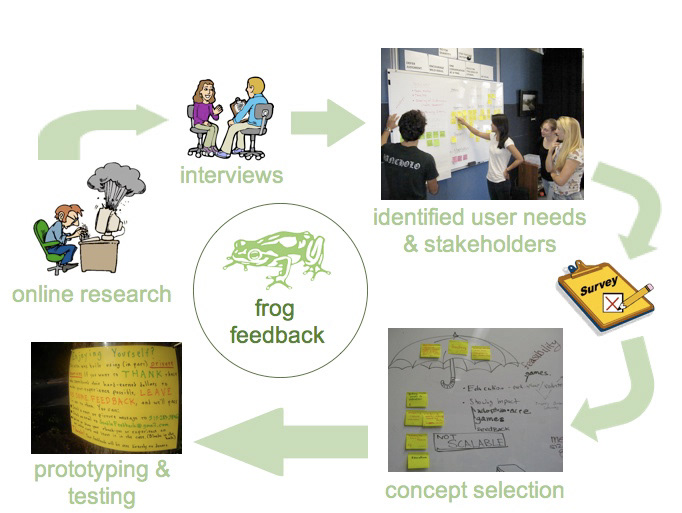
An overview of the process we took to arrive at our final concept.
User Needs & Stakeholders:
We began this project by conducting interviews of all possible users and stakeholders. We then reviewed the interviews as a team and organized needs based on the primary users & stakeholders. We identified main user/stakeholder groups and compared needs related to each in order to find commonalities and the overarching needs for the project.
We began this project by conducting interviews of all possible users and stakeholders. We then reviewed the interviews as a team and organized needs based on the primary users & stakeholders. We identified main user/stakeholder groups and compared needs related to each in order to find commonalities and the overarching needs for the project.
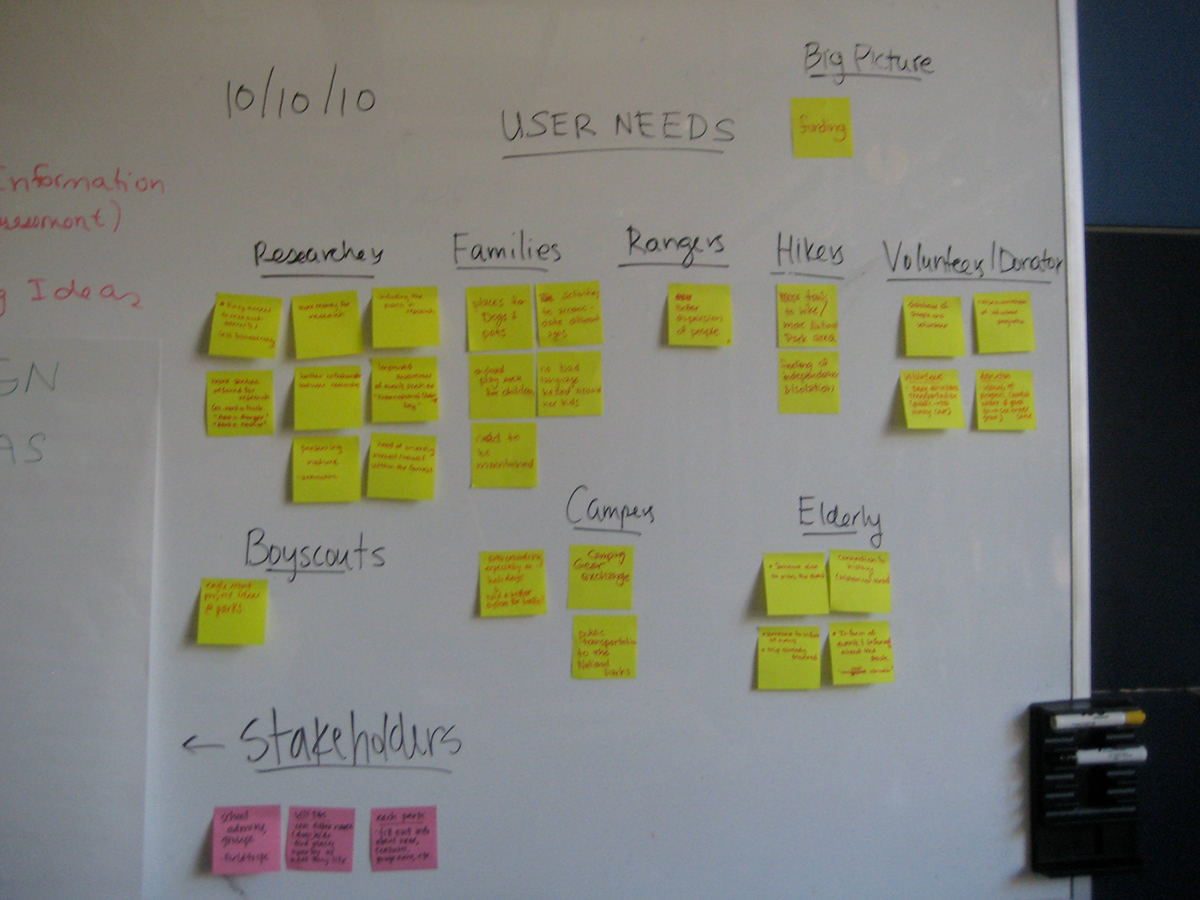
Needs clustered according to users & stakeholders

Comparing the needs of all user/stakeholder groups, we identified six needs that were expressed by many of the informants. We then investigated each need and conducted research of current attempts within parks to address each of these needs.
Keeping all this in mind, we developed our first mission statement for the project.
"To strengthen the user experience and attachment to the parks. We see this most effectively accomplished by promoting community-facilitated research and volunteer opportunities."
Keeping all this in mind, we developed our first mission statement for the project.
"To strengthen the user experience and attachment to the parks. We see this most effectively accomplished by promoting community-facilitated research and volunteer opportunities."
Finding a Focus:
Our initial research and benchmarking revealed that many of these needs are already being addressed by other organizations and parks. In order to aid us again in determining a scope for the project, we developed three main criteria: Feasibility, Scalability, and Group's Interest. As a team, we then discussed how strongly each of us felt about the importance of this criteria and whether we were content with a design that was conceptual or one that we would begin implementing by the end of the semester.
Summary of the Findings:
-Feasibility = We want a finished product that is ready to be tested and implemented. We will lightly work with potential users to develop a user base who could be the first user to implement this product later.
Our initial research and benchmarking revealed that many of these needs are already being addressed by other organizations and parks. In order to aid us again in determining a scope for the project, we developed three main criteria: Feasibility, Scalability, and Group's Interest. As a team, we then discussed how strongly each of us felt about the importance of this criteria and whether we were content with a design that was conceptual or one that we would begin implementing by the end of the semester.
Summary of the Findings:
-Feasibility = We want a finished product that is ready to be tested and implemented. We will lightly work with potential users to develop a user base who could be the first user to implement this product later.
-Scalability = We are starting with one user group at one park and designing for them. This should be a good starting point for increasing the scale to this type of user at all parks.
-Group's interest. = There is a general consensus that we like issues related to national parks and wildlife refuges in general so any topic within this area will be up interest.
We narrowed needs in three main stages according to initial research, our selection criteria, and quick concept generation. Finally, we selected "Education" as the overall need we wanted to pursue. We felt that many of the other needs such as "Increase attachment to the parks" and "Getting people to volunteer" could be accomplished by first encouraging education of the parks. Specifically, we interpreted education to mean helping people to find a more interactive way to learn about nature and the different challenges parks face. We intended to promote education by creating an educational game that could be distributed at the parks.
We narrowed needs in three main stages according to initial research, our selection criteria, and quick concept generation. Finally, we selected "Education" as the overall need we wanted to pursue. We felt that many of the other needs such as "Increase attachment to the parks" and "Getting people to volunteer" could be accomplished by first encouraging education of the parks. Specifically, we interpreted education to mean helping people to find a more interactive way to learn about nature and the different challenges parks face. We intended to promote education by creating an educational game that could be distributed at the parks.

Top Needs and three "umbrella needs"

After quick concept generation and benchmarking, we discovered that education has already been explored quite in depth by other organizations and that many products similar to what we had envisioned are already in existence. We then once again changed our direction for the project and decided that we could make the most significant impact exploring opportunities to promote donations and increase funding to the parks.
Concept Generation - Funding:
Once settled on exploring the possibilities related to funding, we again each developed concepts which we presented to the team. One concept that I was particularly excited about was the idea of encouraging micro-donations by using a model similar to Heifer International, simply the "Heifer International for Parks."
Once settled on exploring the possibilities related to funding, we again each developed concepts which we presented to the team. One concept that I was particularly excited about was the idea of encouraging micro-donations by using a model similar to Heifer International, simply the "Heifer International for Parks."
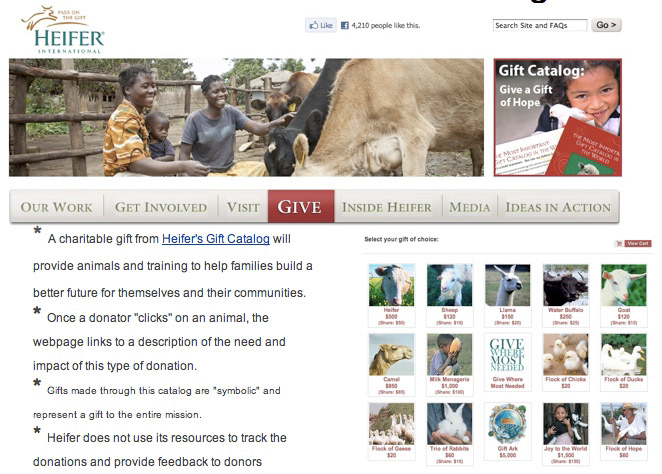
The idea with this concept is that potential donors could specifically select to which project they wanted their donations to be contributed. Users would be able to search a database online for specific areas of the parks that required donations. We felt that one of the main obstacles preventing people from donating to the parks is the current rather impersonal experience. This concept, on the other hand, would make the experience of donating to the parks a personal undertaking.
Concept Selection:
We used a Pugh selection matrix to evaluate how effective each of our six top concepts address the goals we identified for our team. Using this method, concepts #1 and #2 emerged as the concepts that fit best with our overall goals.
We then developed our final mission statement:
"We will create a Positive Feedback Loop for donators in order to increase funding for National Parks. We will need to identify specific donators who will receive this positive feedback for their donations, thus in order to do this we may set up a website for specific donation opportunities."
We used a Pugh selection matrix to evaluate how effective each of our six top concepts address the goals we identified for our team. Using this method, concepts #1 and #2 emerged as the concepts that fit best with our overall goals.
We then developed our final mission statement:
"We will create a Positive Feedback Loop for donators in order to increase funding for National Parks. We will need to identify specific donators who will receive this positive feedback for their donations, thus in order to do this we may set up a website for specific donation opportunities."
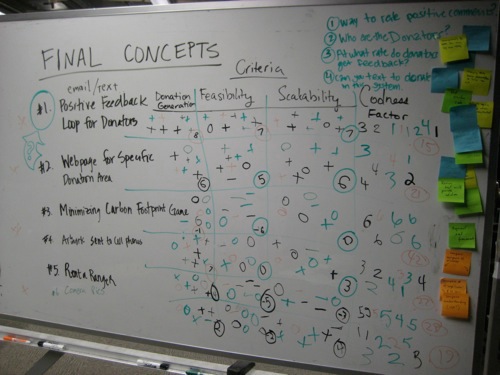
Prototyping:
One aspect of our final concept was to establish a texting service that would collect positive feedback while people are spending time in parks. We decided to use the UC Berkeley campus as a first step in prototyping.
Prototype #1:
I personally created low fidelity prototypes of signs welcoming users to text feedback about their experience to the number provided. Unfortunately, after weeks of the signs being in place we only received one text in response. I posted signs at a variety of locations around campus in areas where people tend to congregate outdoors.
Prototype #2 & #3:
My team member Aryn Shelander created a second prototype that was a modification of the sign depicted below to interview 20+ residents of the International House. In addition, Dylan Fox created an online survey asking users to imagine themselves donating to the parks. All of our initial prototypes revealed that signs partnered with texting were not an effective means of gathering positive feedback.
One aspect of our final concept was to establish a texting service that would collect positive feedback while people are spending time in parks. We decided to use the UC Berkeley campus as a first step in prototyping.
Prototype #1:
I personally created low fidelity prototypes of signs welcoming users to text feedback about their experience to the number provided. Unfortunately, after weeks of the signs being in place we only received one text in response. I posted signs at a variety of locations around campus in areas where people tend to congregate outdoors.
Prototype #2 & #3:
My team member Aryn Shelander created a second prototype that was a modification of the sign depicted below to interview 20+ residents of the International House. In addition, Dylan Fox created an online survey asking users to imagine themselves donating to the parks. All of our initial prototypes revealed that signs partnered with texting were not an effective means of gathering positive feedback.
Prototype #4:
Using the feedback from the initial prototypes, we then created a prototype designed to collect analog feedback from users. This prototype received more than 19 responses in only a fraction of the time the other prototypes were in effect.
Using the feedback from the initial prototypes, we then created a prototype designed to collect analog feedback from users. This prototype received more than 19 responses in only a fraction of the time the other prototypes were in effect.
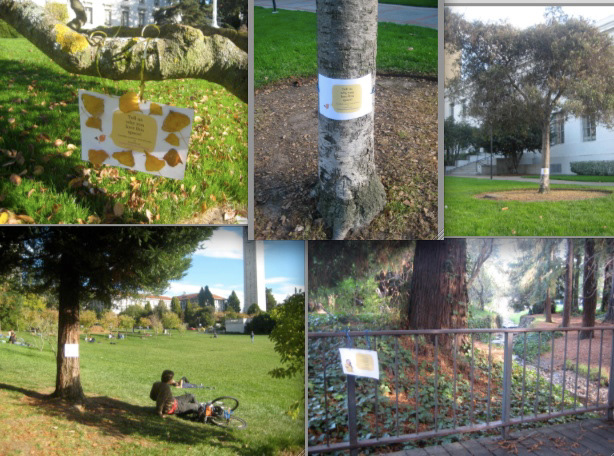
Locations of Prototype #1
Final Concept:
Our final design incorporated the lessons learned from our previous prototypes, particularly emphasizing the importance of analog feedback.
Features:
- A collection box located at popular spots outdoors such as rest spots and trail heads. The idea is that users would fill out feedback forms and place them in the collection bin.
- Online database of positive feedback from users of the parks. This would require that someone working in the park would collect the analog feedback and upload it to the database. Donors are then able to view the feedback online.
- A mail service that would then send the physical copies of the feedback directly to the donors. We believe that donors will be most likely to donate again if they receive personal, handwritten feedback.
Our final design incorporated the lessons learned from our previous prototypes, particularly emphasizing the importance of analog feedback.
Features:
- A collection box located at popular spots outdoors such as rest spots and trail heads. The idea is that users would fill out feedback forms and place them in the collection bin.
- Online database of positive feedback from users of the parks. This would require that someone working in the park would collect the analog feedback and upload it to the database. Donors are then able to view the feedback online.
- A mail service that would then send the physical copies of the feedback directly to the donors. We believe that donors will be most likely to donate again if they receive personal, handwritten feedback.

Depiction of the final concept created by Aryn Shelander using Phototshop
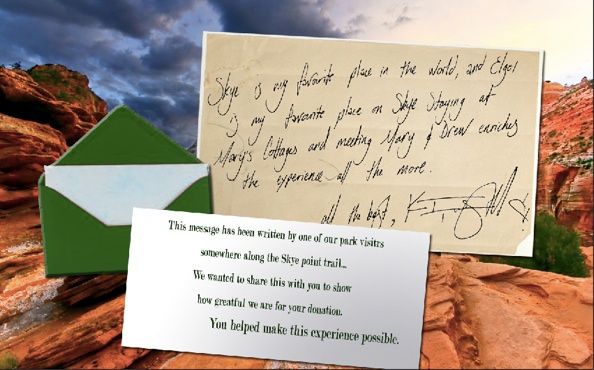
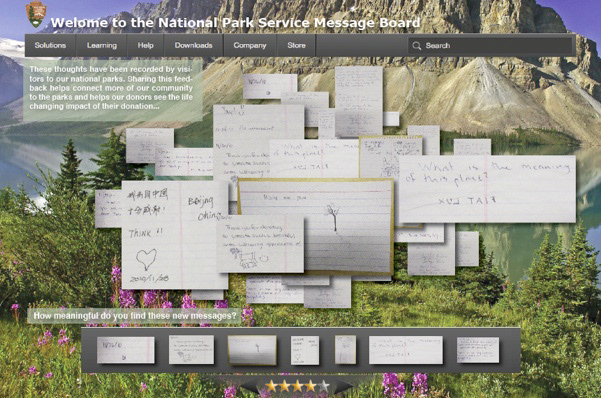
Acknowledgements:
We'd like to thank the professionals at frog design for their guidance throughout the project: Mike Shay, Anton Ljunggren, Catherine Sun, and Paul Bradley. Also, our Berkeley Institute of Design advisor Lora Oehlberg and the members of Berkeley Innovation.
We'd like to thank the professionals at frog design for their guidance throughout the project: Mike Shay, Anton Ljunggren, Catherine Sun, and Paul Bradley. Also, our Berkeley Institute of Design advisor Lora Oehlberg and the members of Berkeley Innovation.


